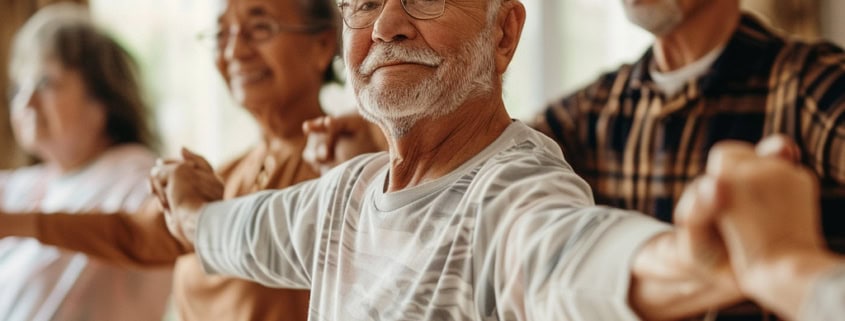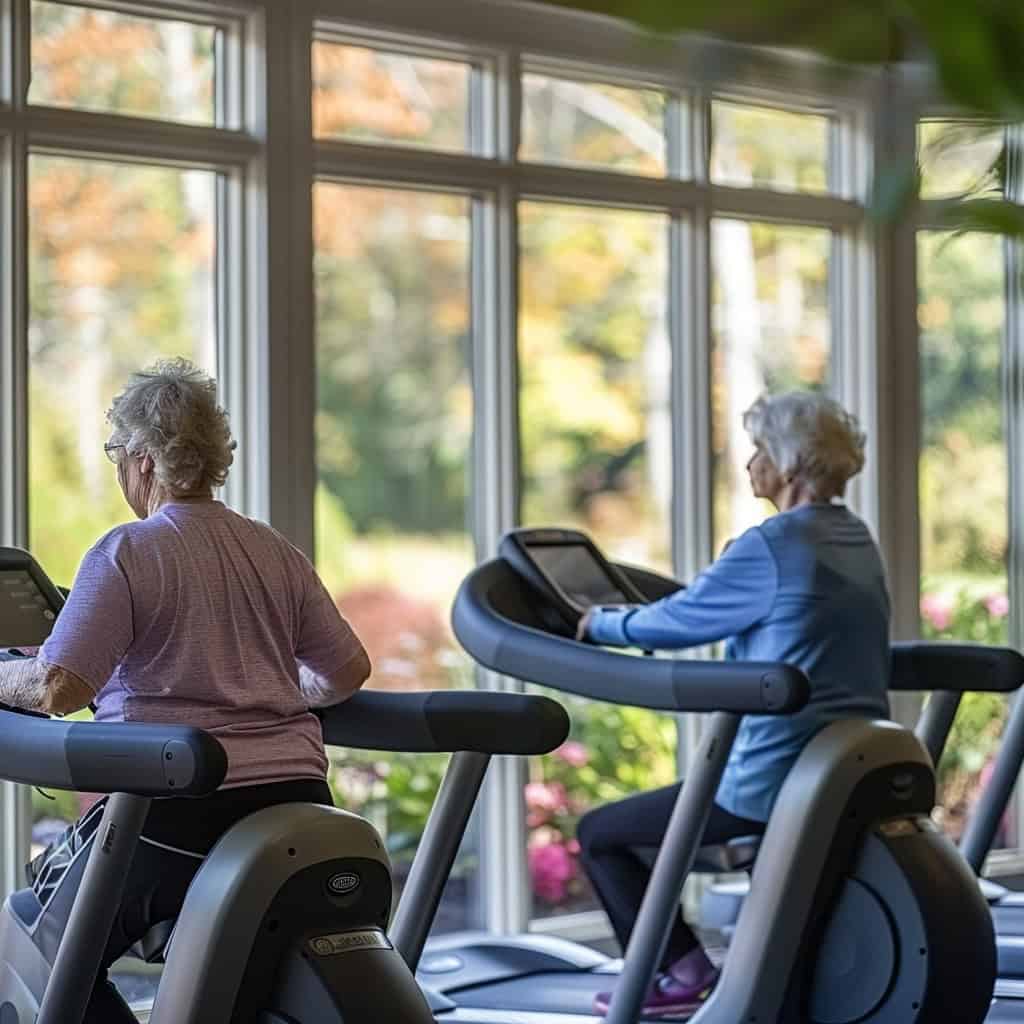Senior Exercise Programs to Promote Health & Wellness
As the population ages, residential care facilities for the elderly (RCFEs) play a crucial role in ensuring the health and wellness of their residents.
Regular physical activity is one of the most effective ways to promote overall well-being in seniors.
Exercise programs tailored to the needs and abilities of older adults can significantly enhance their quality of life, helping them maintain independence, reduce the risk of chronic diseases, and improve mental health.
This article explores the benefits of senior exercise programs and offers practical tips for implementing them in residential care facilities for the elderly.
The Importance of Exercise for Seniors Physical Benefits
- Improved Mobility and Flexibility
Regular exercise helps maintain and improve flexibility, strength, and balance. These physical attributes are essential for daily activities such as walking, bending, and lifting, which in turn help seniors remain independent for longer.
Flexibility exercises like stretching routines or yoga tailored for the elderly can prevent stiffness and enhance the range of motion, which is crucial for performing everyday tasks.
- Cardiovascular Health
Aerobic exercises like walking, swimming, and cycling can improve heart health, reduce blood pressure, and lower the risk of heart disease.
Activities to keep seniors active also enhance respiratory efficiency, ensuring better oxygen circulation throughout the body. Improved cardiovascular health means a reduced risk of strokes and heart attacks, common concerns among the elderly.
- Bone Health
Weight-bearing exercises such as walking, jogging, and resistance training are crucial for maintaining bone density and reducing the risk of osteoporosis and fractures. Strong bones are vital for preventing serious injuries resulting from falls, which are a significant risk for seniors.
- Weight Management
Regular physical activity helps maintain a healthy weight, essential for managing and preventing chronic conditions such as diabetes, hypertension, and arthritis. Maintaining a healthy weight can also alleviate pressure on joints, reduce pain, and improve mobility.
Psychological and Emotional Benefits
- Cognitive Function
Exercise has been shown to improve cognitive function, slow down the progression of dementia, and enhance memory and attention.
Physical activity increases blood flow to the brain, promoting neurogenesis and overall brain health. Cognitive exercises combined with physical activity, such as dance-type movements or aerobics classes that require memorization of steps, can be particularly beneficial.
- Mood Enhancement
Physical activity stimulates the release of endorphins, the body’s natural mood lifters. Regular exercise can help alleviate symptoms of depression and anxiety, promoting a positive outlook on life.
Activities that combine social interaction and physical movement, like group exercises, can further enhance these benefits.
- Social Interaction
Group exercise programs provide opportunities for socialization, reducing feelings of loneliness and isolation. Social interaction is vital for mental health, especially for seniors who may feel disconnected from their families or communities.
Forming exercise groups can foster a sense of belonging and community within the assisted living facility.
Designing Effective Exercise Programs for Seniors
When designing exercise programs for seniors in residential care facilities, it’s essential to consider the diverse needs and abilities of the residents.
Programs should be inclusive, adaptable, and enjoyable to ensure maximum participation and benefit.
It will also be important to provide RCFE caregiver training that educates your RCFE staff about the benefits of senior exercise and how such programs can help your residents.
Assessment and Personalization
- Initial Assessment
Conduct a thorough assessment of each resident’s physical capabilities, medical conditions, and personal preferences. This will help in creating personalized exercise plans that are safe and effective. Assessments should include evaluations of mobility, strength, balance, and any chronic health conditions.
- Individualized Plans
Tailor exercise programs to each resident’s specific needs using the assessment information.
Personalization ensures that each resident can participate safely and effectively. Regularly review and adjust these plans to accommodate any changes in health or ability.
Categories of Exercise for Seniors
- Aerobic Exercises
Activities like walking, swimming, and cycling are excellent for cardiovascular health. Aim for moderate-intensity aerobic exercise for at least 150 minutes per week, as health guidelines recommend.
However, any amount of exercise will convey benefits compared to none. Group walks, water aerobics, and stationary cycling classes are great options.
- Strength Training
Resistance exercises using weights, resistance bands, or body weight help build and maintain muscle mass. Strength training should be done at least twice a week, focusing on major muscle groups.
These sessions can include exercises like squats, lunges, bicep curls, and shoulder presses. Such exercises can be adapted for seniors in ways that do not require a high range of motion and ensure safety. Maintaining muscle mass is one of the most critical health factors related to exercise for seniors.
- Balance and Flexibility
Incorporate exercises that enhance balance and flexibility, such as yoga, tai chi, and stretching routines. These exercises help prevent falls and improve overall mobility. Balance exercises might include standing on one leg or heel-to-toe walking, while flexibility exercises can involve various stretching techniques.
- Functional Exercises
Include exercises that mimic everyday activities, such as standing up from a chair, reaching overhead, or bending to pick up objects. These exercises improve functional fitness, making daily tasks easier and safer. Functional training can also include practice with assistive devices if needed.
Implementation Strategies
- Qualified Instructors
Ensure that exercise programs are led by qualified instructors with experience in working with older adults. They should be knowledgeable about senior fitness and capable of adapting exercises to individual needs. Look for certifications in senior fitness or geriatric exercise.
- Safe Environment
Create a safe and comfortable environment for exercise. Ensure the exercise area is well-lit, free of obstacles, and equipped with safety features like handrails and non-slip flooring. Safety should always be a top priority to prevent injuries.
- Encouragement and Motivation
Foster a supportive atmosphere where residents feel encouraged to participate. Use positive reinforcement and celebrate achievements to keep motivation high. Consider using motivational tools like music, themed classes, or friendly competitions.
- Consistency and Routine
Establish a regular schedule for exercise sessions to create a routine. Consistency is critical to reaping the long-term benefits of physical activity. Schedule classes at the same times each week and remind residents of upcoming sessions.
Examples of Exercise Programs Implemented for RCFE Residents
Below are examples of exercise programs implemented in RCFEs to promote health and wellness among seniors. Videos of these exercises tailored for the elderly can be found widely online.
- Chair-Based Exercises
- Walking Clubs
- Water Aerobics
- Dance Classes
- Strength Training Sessions
- Yoga and Tai Chi
- Group Exercise Classes
Monitoring Progress and Adjusting Programs
Regularly monitor the progress of residents participating in exercise programs. Conduct periodic assessments to evaluate strength, flexibility, balance, and overall fitness improvements. Use this information to adjust and personalize exercise plans as needed.
Understanding ways to facilitate better care for your residents will be part of the knowledge set required to obtain your assisted living license.
Feedback and Adaptation
Encourage residents to provide feedback on the exercise programs. Understand their likes, dislikes, and any challenges they face. Use this feedback to adapt and improve the programs, ensuring they remain enjoyable and beneficial. Surveys, suggestion boxes, and regular check-ins can effectively gather feedback.
Celebrating Success
Celebrate the achievements of residents to boost motivation and morale. Recognize milestones like improved mobility, increased endurance, or consistent participation. Celebrations can include certificates, awards, or special events. Hosting an annual fitness day or a showcase event where residents can demonstrate their progress can be very motivating.
Conclusion
Implementing senior exercise programs in RCFEs is a powerful way to promote health and wellness among residents. These programs offer numerous physical, mental, and emotional benefits, helping seniors maintain independence, reduce the risk of chronic diseases, and improve their overall quality of life.
By designing inclusive, personalized, and enjoyable exercise programs, RCFEs can create a vibrant and supportive environment that encourages residents to stay active and healthy.
Investing in the health and wellness of seniors through regular physical activity enhances their individual well-being and contributes to a positive and thriving community within the assisted living facility.
With careful planning, qualified instructors, and a commitment to continuous improvement, senior exercise programs can become a cornerstone of a holistic approach to elder care, ensuring that residents enjoy their golden years to the fullest.





